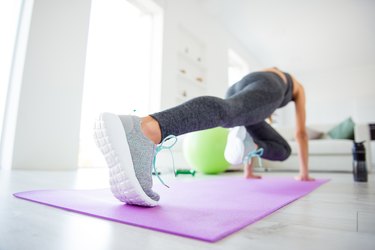
Calf raises strengthen your calf muscles, which are the soleus, gastrocnemius and plantaris. Over-exerting your calf muscles along with poor flexibility can result in calf tightness or stiffness and injury. Treatment consists of rest, ice and light stretches. Consult your physician if you have pain or persistent symptoms.
Calf Muscle Cramps
Video of the Day
Muscle cramps are common in your calf muscles, according to the American Academy of Orthopaedic Surgeons. Muscle cramps are when your calf muscles contract uncontrollably, resulting in calf tightness and intense pain.
Video of the Day
Performing calf raises after a high-intensity workout or with additional resistance like dumbbells can lead to cramping. Dehydration and electrolyte imbalances like low sodium may increase your risk of sustaining a muscle cramp in your calf as well.
Sore Calves After Calf Raises
A forceful contraction of your calf muscles during calf raises can cause a muscle strain or tear. A muscle strain can be a partial tear of your calf muscle or in severe cases a complete rupture. Symptoms of a muscle strain include calf stiffness, pain and swelling. Fatigue, weak calf muscles and inflexibility can increase your risk of sustaining a calf muscle strain.
Read more: How to Treat Sore Calves
Although any one of your calf muscles can tear, the gastrocnemius muscle is more susceptible to strains because it crosses both the knee and ankle joints and contracts quickly and forcefully. According to a 2017 study published by International Journal of Exercise Science, people who sustain gastrocnemius muscle injury often report calf tightness as a precipitating factor.
Chronic Exertional Compartment Syndrome
Your lower leg is separated into compartments, with your calf muscles in the posterior compartment. With the exertion of exercise, your calf muscles can swell and build-up pressure in the compartment. Chronic exertional compartment syndrome occurs when too much pressure is in the posterior compartment, restricting blood flow and oxygen to your muscles. Symptoms include calf tightness, sore calf muscle, a burning or aching feeling and numbness or tingling.
Stiff Calf Interventions
To decrease any swelling and pain, follow the acronym RICE, which stands for rest, ice, compression and elevation. Calf-stretches, orthotics and over-the-counter pain medications such as acetaminophen might also help reduce stiffness and pain. Check with your doctor to be sure these medications are safe for you. Additional treatments include physical therapy and massage therapy.
If you suspect you have chronic exertional compartment syndrome, seek immediate medical attention. Surgery or a fasciotomy may be recommended. During this procedure, tissue separating the compartments in your calf is surgically cut to release the pressure.
Preventing Sore Calf Muscle
To prevent additional calf stiffness and injury, increase your repetitions, sets and resistance slowly. Warm up your muscles with a five-minute walk or jog prior to exercising, and stretch your calf muscles afterwards to maintain flexibility.
The standing calf stretch, for example, is performed in a staggered stance with your injured leg back. Slowly lean or lunge forward while keeping your back heel down. Hold this position for 15 to 30 seconds and repeat one to three times. To prevent dehydration and electrolyte imbalance, drink at least eight glasses of water daily and eat a well-balanced diet.
Read more: How to Reduce Calf Pain When Running
Is this an emergency? If you are experiencing serious medical symptoms, please see the National Library of Medicine’s list of signs you need emergency medical attention or call 911.